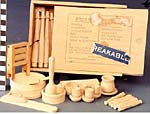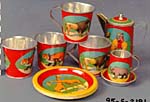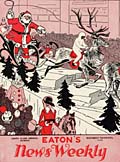In addition to the Eaton's seasonal catalogues, a number of
specialty
catalogues, including one-time catalogues, such as the Klondike Catalogue
(1898)
and the Settlers' Catalogue (1903), and others that were published
for
many years, including catalogues of houses and barns, wallpaper and paint,
light
fixtures, sheet music and books, and seeds and groceries. Some of these
were
only 32-page booklets, others were quite thick. First published in 1897,
the
most anticipated catalogue of the year was the Christmas catalogue, which,
by
the 1950s, grew to be a wishing book of more than 200 pages.
Christmas catalogues were relatively small in the early 20th century so
orders
were also placed from the extensive fall-and-winter catalogue. Suggestions
were
offered for small, practical gifts such as handkerchiefs, slippers,
accessories,
jewellery, watches, binoculars, pencils and fountain pens, perfumes,
makeup,
toilet sets, shaving equipment, silverware, pocket knives, linens, down
comforters,
and sewing baskets. Beads and native goods, moccasins, sweet-grass baskets
and
"tourist art," books, toys, and skates ("Just what a boy
wants
for Christmas") were also recommended.
Christmas was a relatively low-key event at the time, focused on
family, church,
and community. It was a magical, not materialistic, time. Children looked
forward
to the arrival of the Eaton's catalogues and to dreaming about what
they
might receive. After the order was placed, they awaited its delivery with
anticipation.
Children were sometimes allowed to pick out one gift for themselves, but
rarely
gave presents to their parents unless they were homemade.
Accounts of the period note that people spent only what they could
afford
at Christmas. They lived within their means. Families were considerably
larger
than they are today and gift giving was less common and less effusive. For
farmers,
a good year allowed for a larger order. The fall order went in after
harvest,
when the family would know how successful their season had been.
| |
 |
|
This set of Easy Sewing
Cards
for Tiny Tots made by Milton Bradley contained eight cards, perforated
in different designs, four skeins of coloured thread, and two needles.
It sold for 45 cents in the Eaton's (Winnipeg) Fall/Winter Catalogue,
1919-20, p. 435.
|
 |
|
|
| |
| |
 |
|
This Dolly Household Set
consisted
of a miniature washtub, washboard, clothes wringer, iron, ironing board,
table, chopping bowl, potato masher, rolling pin, six clothespins, cup
and saucer, and pot. All were made from "wood, smoothly finished." The
set sold for 35 cents through the Eaton's (Winnipeg) Fall/Winter Catalogue,
1919-20, p. 437.
|
 |
|
|
| |
| |
 |
|
Little girls must have had
fun playing "tea party" with this lithographed tin tea set. It was sold
for 50 cents in the Eaton's (Winnipeg) Fall/Winter Catalogue, 1915-16,
p. 278.
|
 |
|
|
|
Christmas Was a Time for Children
| |
 |
|
| |
 Cover
announcing the arrival of Santa Claus in Eaton's News Weekly, 1926. Cover
announcing the arrival of Santa Claus in Eaton's News Weekly, 1926.
|
|
| |
|
|
|
Children did not receive many gifts during this period, but they
enjoyed looking
at the catalogue and dreaming about the things that they would like to
receive.
Many Canadians who were children in the 1920s and '30s remember spending a
lot
of time thumbing through the catalogue. One family played a game: If you
could
pick one thing from every page, what would you pick? In reality, they were
only
allowed to pick out one thing from the entire catalogue, as there
wasn't
a lot of money around, but these times are remembered as happy
Christmases. Another
woman from Alberta remembers receiving dolls. "All the time dolls
... They
were just small, baby dolls. They weren't the big, Eaton
dolls."
A similar memory from British Columbia was of three sisters each getting
"a
doll and each doll had a little cradle that was made so it would fold up,
something
like an accordion. They were ordered from Eaton's. They were really
special."
For boys, trucks and farm sets were popular. One woman remembers that
her
son Gordon wanted a truck just like his father's. They sent to
Eaton's
for the truck with money earned by selling railroad ties. The boy was so
excited
he could hardly get to sleep on Christmas Eve. Another man described the
farm
set made in England that he received from the catalogue as a boy in the
1920s,
how he played with it, and added to his collection of animals each year.
|